Pharmacology and Pharmacotherapeutics Assignment
VerifiedAdded on 2021/04/16
|16
|3650
|128
AI Summary
This assignment is a compilation of various pharmacological topics, including the mechanism of action, dosage, usage, and side effects of several medications such as ceftriaxone, salbutamol, tiotropium/olodaterol, budesonide/formoterol fumarate dihydrate, and more. It also includes references to various studies and publications related to these topics.
Contribute Materials
Your contribution can guide someone’s learning journey. Share your
documents today.

Running head: CLINICAL SCENARIO REPORT
Clinical scenario report
Name of the student:
Name of the University:
Author’s note
Clinical scenario report
Name of the student:
Name of the University:
Author’s note
Secure Best Marks with AI Grader
Need help grading? Try our AI Grader for instant feedback on your assignments.

1CLINICAL SCENARIO REPORT
Pathophysiology
1.1 Pathophysiology of COPD:
The report is concerned with the case scenario of Robert, a 51 year old man admitted to
hospital for acute exacerbation of chronic obstructive pulmonary disease (COPD). COPD is a
progressive lung disease associated with airflow obstruction and abnormal inflammatory
response. Inflammatory response is seen due to exposure to noxious fumes like cigarette
smoke and chemical fumes. The activation of T –lymphocyte, B cells and neutrophils leads to
the initiation of an inflammatory cascade and many inflammatory mediators like fibrinogen,
C reactive protein and interleukins are released. These inflammatory mediators play a major
role in sustaining the inflammatory process and causing systemic changes and tissue damage
(Brashier & Kodgule, 2012). Due to such structural changes, clinical presentation of airflow
Pathophysiology
1.1 Pathophysiology of COPD:
The report is concerned with the case scenario of Robert, a 51 year old man admitted to
hospital for acute exacerbation of chronic obstructive pulmonary disease (COPD). COPD is a
progressive lung disease associated with airflow obstruction and abnormal inflammatory
response. Inflammatory response is seen due to exposure to noxious fumes like cigarette
smoke and chemical fumes. The activation of T –lymphocyte, B cells and neutrophils leads to
the initiation of an inflammatory cascade and many inflammatory mediators like fibrinogen,
C reactive protein and interleukins are released. These inflammatory mediators play a major
role in sustaining the inflammatory process and causing systemic changes and tissue damage
(Brashier & Kodgule, 2012). Due to such structural changes, clinical presentation of airflow
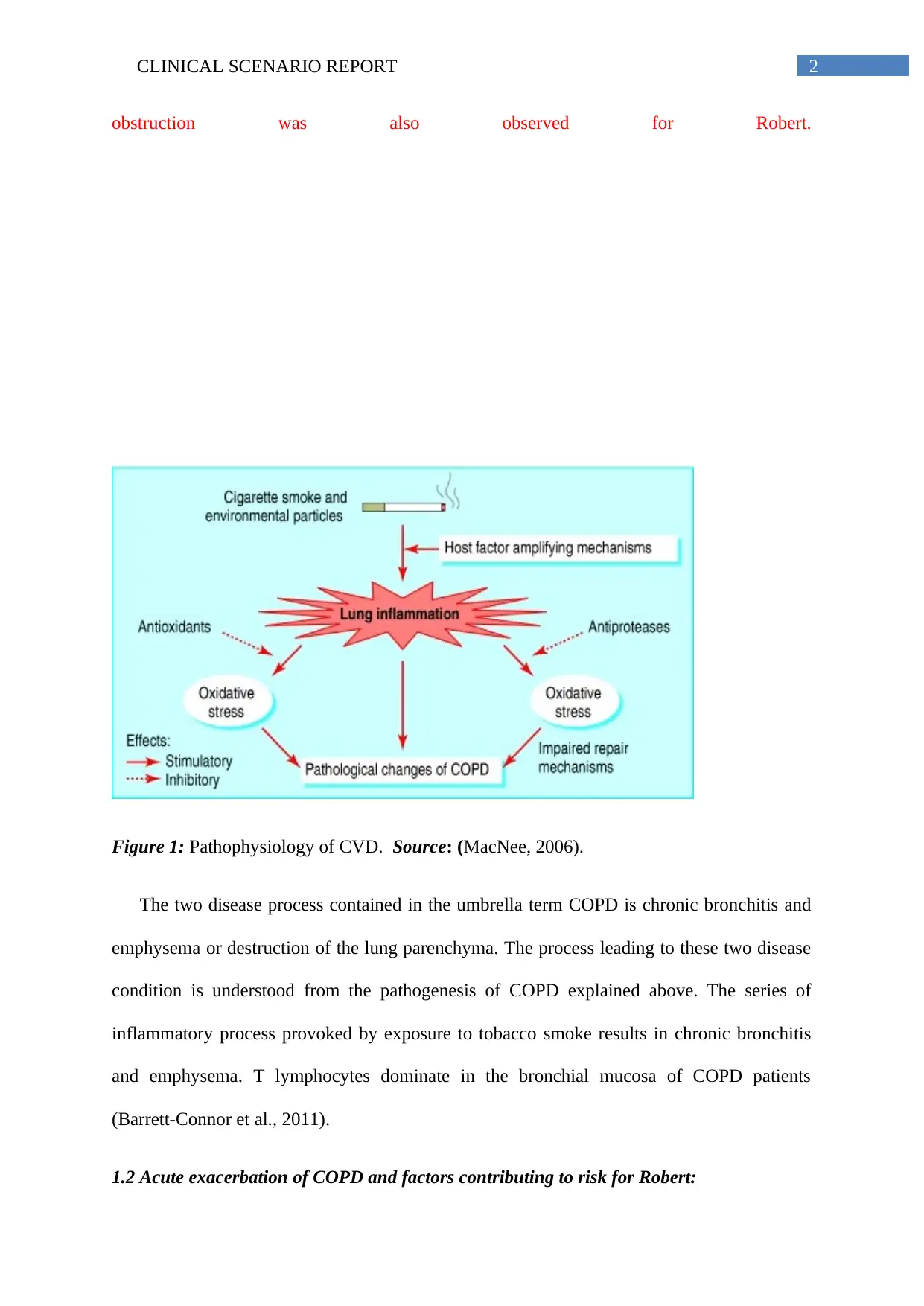
2CLINICAL SCENARIO REPORT
obstruction was also observed for Robert.
Figure 1: Pathophysiology of CVD. Source: (MacNee, 2006).
The two disease process contained in the umbrella term COPD is chronic bronchitis and
emphysema or destruction of the lung parenchyma. The process leading to these two disease
condition is understood from the pathogenesis of COPD explained above. The series of
inflammatory process provoked by exposure to tobacco smoke results in chronic bronchitis
and emphysema. T lymphocytes dominate in the bronchial mucosa of COPD patients
(Barrett-Connor et al., 2011).
1.2 Acute exacerbation of COPD and factors contributing to risk for Robert:
obstruction was also observed for Robert.
Figure 1: Pathophysiology of CVD. Source: (MacNee, 2006).
The two disease process contained in the umbrella term COPD is chronic bronchitis and
emphysema or destruction of the lung parenchyma. The process leading to these two disease
condition is understood from the pathogenesis of COPD explained above. The series of
inflammatory process provoked by exposure to tobacco smoke results in chronic bronchitis
and emphysema. T lymphocytes dominate in the bronchial mucosa of COPD patients
(Barrett-Connor et al., 2011).
1.2 Acute exacerbation of COPD and factors contributing to risk for Robert:
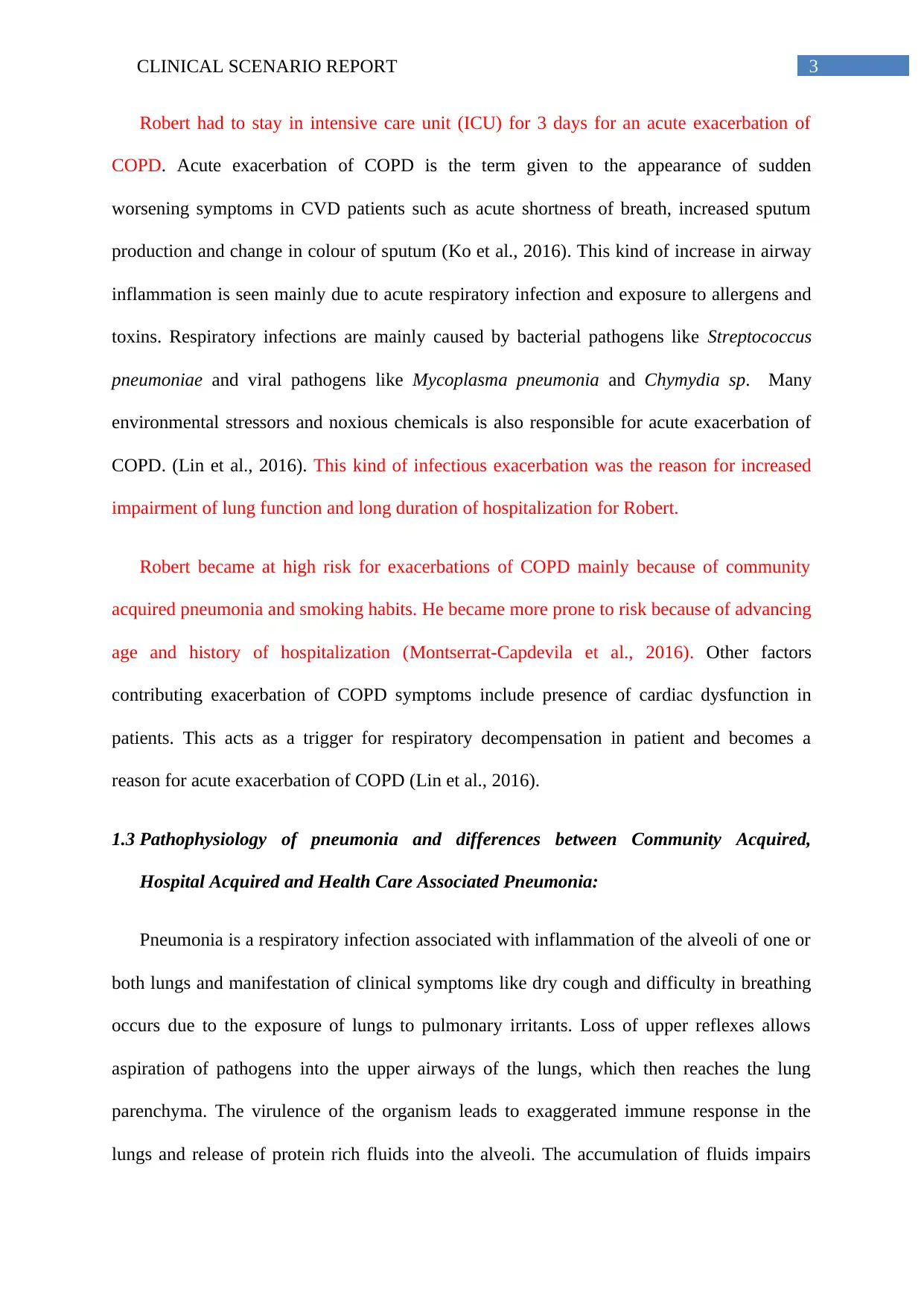
3CLINICAL SCENARIO REPORT
Robert had to stay in intensive care unit (ICU) for 3 days for an acute exacerbation of
COPD. Acute exacerbation of COPD is the term given to the appearance of sudden
worsening symptoms in CVD patients such as acute shortness of breath, increased sputum
production and change in colour of sputum (Ko et al., 2016). This kind of increase in airway
inflammation is seen mainly due to acute respiratory infection and exposure to allergens and
toxins. Respiratory infections are mainly caused by bacterial pathogens like Streptococcus
pneumoniae and viral pathogens like Mycoplasma pneumonia and Chymydia sp. Many
environmental stressors and noxious chemicals is also responsible for acute exacerbation of
COPD. (Lin et al., 2016). This kind of infectious exacerbation was the reason for increased
impairment of lung function and long duration of hospitalization for Robert.
Robert became at high risk for exacerbations of COPD mainly because of community
acquired pneumonia and smoking habits. He became more prone to risk because of advancing
age and history of hospitalization (Montserrat-Capdevila et al., 2016). Other factors
contributing exacerbation of COPD symptoms include presence of cardiac dysfunction in
patients. This acts as a trigger for respiratory decompensation in patient and becomes a
reason for acute exacerbation of COPD (Lin et al., 2016).
1.3 Pathophysiology of pneumonia and differences between Community Acquired,
Hospital Acquired and Health Care Associated Pneumonia:
Pneumonia is a respiratory infection associated with inflammation of the alveoli of one or
both lungs and manifestation of clinical symptoms like dry cough and difficulty in breathing
occurs due to the exposure of lungs to pulmonary irritants. Loss of upper reflexes allows
aspiration of pathogens into the upper airways of the lungs, which then reaches the lung
parenchyma. The virulence of the organism leads to exaggerated immune response in the
lungs and release of protein rich fluids into the alveoli. The accumulation of fluids impairs
Robert had to stay in intensive care unit (ICU) for 3 days for an acute exacerbation of
COPD. Acute exacerbation of COPD is the term given to the appearance of sudden
worsening symptoms in CVD patients such as acute shortness of breath, increased sputum
production and change in colour of sputum (Ko et al., 2016). This kind of increase in airway
inflammation is seen mainly due to acute respiratory infection and exposure to allergens and
toxins. Respiratory infections are mainly caused by bacterial pathogens like Streptococcus
pneumoniae and viral pathogens like Mycoplasma pneumonia and Chymydia sp. Many
environmental stressors and noxious chemicals is also responsible for acute exacerbation of
COPD. (Lin et al., 2016). This kind of infectious exacerbation was the reason for increased
impairment of lung function and long duration of hospitalization for Robert.
Robert became at high risk for exacerbations of COPD mainly because of community
acquired pneumonia and smoking habits. He became more prone to risk because of advancing
age and history of hospitalization (Montserrat-Capdevila et al., 2016). Other factors
contributing exacerbation of COPD symptoms include presence of cardiac dysfunction in
patients. This acts as a trigger for respiratory decompensation in patient and becomes a
reason for acute exacerbation of COPD (Lin et al., 2016).
1.3 Pathophysiology of pneumonia and differences between Community Acquired,
Hospital Acquired and Health Care Associated Pneumonia:
Pneumonia is a respiratory infection associated with inflammation of the alveoli of one or
both lungs and manifestation of clinical symptoms like dry cough and difficulty in breathing
occurs due to the exposure of lungs to pulmonary irritants. Loss of upper reflexes allows
aspiration of pathogens into the upper airways of the lungs, which then reaches the lung
parenchyma. The virulence of the organism leads to exaggerated immune response in the
lungs and release of protein rich fluids into the alveoli. The accumulation of fluids impairs
Secure Best Marks with AI Grader
Need help grading? Try our AI Grader for instant feedback on your assignments.

4CLINICAL SCENARIO REPORT
oxygen and carbon dioxide exchange and impairment in gas exchange becomes the cause of
bacterial pneumonia (Arshad et al., 2016).
Pneumonia is classified into three types such as community Acquired, hospital
Acquired and health care associated pneumonia (HCAP). Community acquired pneumonia
(CAP) is a kind of pneumonia that occurs in people who have no contact with hospital setting
or the health care system. Most common pathogen behind community acquired pneumonia
includes Streptococcus pneumoniae, Haemophilus influenza and viruses (Singh, 2012). In
contrast to CAP, hospital acquired pneumonia is a term given to the diagnosis of pneumonia
in patient after 48 to 72 hours of hospital admission. This type of pneumonia is mainly cause
by bacterial pathogens like Staphylococcus aureus and antibiotic resistant bacteria and not
virus. In addition, the third type, HCAP is different from other two types pneumonia in the
fact that it occurs before admission to hospital in patient with recent hospitalization or those
with weakened immune system (Kalil et al., 2016). Robert mainly had community acquired
pneumonia which led to acute exacerbation of COPD.
Pharmacology
2.1 Mechanism of action, contraindication, nursing consideration for three inhalers provided
to Robert:
Robert was taking Salbutamol, Budesonide/Efomoterol fumarate dehydrate, however the
respiratory physician ordered Robert to use Tiotropium instead of Budesonide/Efomoterol
fumarate dehydrate. The details about each of the three inhalers are as follows:
1. Salbutamol
oxygen and carbon dioxide exchange and impairment in gas exchange becomes the cause of
bacterial pneumonia (Arshad et al., 2016).
Pneumonia is classified into three types such as community Acquired, hospital
Acquired and health care associated pneumonia (HCAP). Community acquired pneumonia
(CAP) is a kind of pneumonia that occurs in people who have no contact with hospital setting
or the health care system. Most common pathogen behind community acquired pneumonia
includes Streptococcus pneumoniae, Haemophilus influenza and viruses (Singh, 2012). In
contrast to CAP, hospital acquired pneumonia is a term given to the diagnosis of pneumonia
in patient after 48 to 72 hours of hospital admission. This type of pneumonia is mainly cause
by bacterial pathogens like Staphylococcus aureus and antibiotic resistant bacteria and not
virus. In addition, the third type, HCAP is different from other two types pneumonia in the
fact that it occurs before admission to hospital in patient with recent hospitalization or those
with weakened immune system (Kalil et al., 2016). Robert mainly had community acquired
pneumonia which led to acute exacerbation of COPD.
Pharmacology
2.1 Mechanism of action, contraindication, nursing consideration for three inhalers provided
to Robert:
Robert was taking Salbutamol, Budesonide/Efomoterol fumarate dehydrate, however the
respiratory physician ordered Robert to use Tiotropium instead of Budesonide/Efomoterol
fumarate dehydrate. The details about each of the three inhalers are as follows:
1. Salbutamol
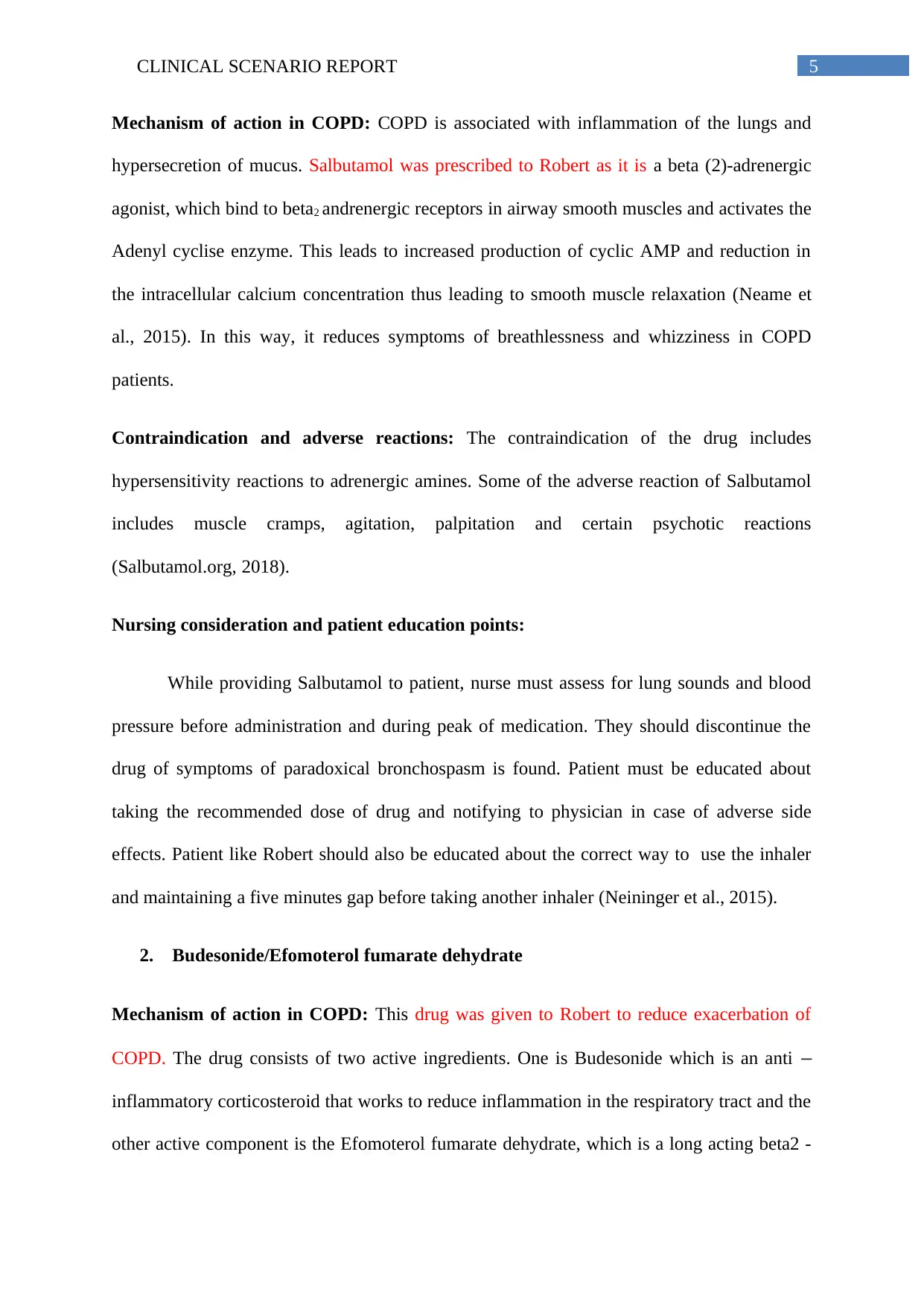
5CLINICAL SCENARIO REPORT
Mechanism of action in COPD: COPD is associated with inflammation of the lungs and
hypersecretion of mucus. Salbutamol was prescribed to Robert as it is a beta (2)-adrenergic
agonist, which bind to beta2 andrenergic receptors in airway smooth muscles and activates the
Adenyl cyclise enzyme. This leads to increased production of cyclic AMP and reduction in
the intracellular calcium concentration thus leading to smooth muscle relaxation (Neame et
al., 2015). In this way, it reduces symptoms of breathlessness and whizziness in COPD
patients.
Contraindication and adverse reactions: The contraindication of the drug includes
hypersensitivity reactions to adrenergic amines. Some of the adverse reaction of Salbutamol
includes muscle cramps, agitation, palpitation and certain psychotic reactions
(Salbutamol.org, 2018).
Nursing consideration and patient education points:
While providing Salbutamol to patient, nurse must assess for lung sounds and blood
pressure before administration and during peak of medication. They should discontinue the
drug of symptoms of paradoxical bronchospasm is found. Patient must be educated about
taking the recommended dose of drug and notifying to physician in case of adverse side
effects. Patient like Robert should also be educated about the correct way to use the inhaler
and maintaining a five minutes gap before taking another inhaler (Neininger et al., 2015).
2. Budesonide/Efomoterol fumarate dehydrate
Mechanism of action in COPD: This drug was given to Robert to reduce exacerbation of
COPD. The drug consists of two active ingredients. One is Budesonide which is an anti –
inflammatory corticosteroid that works to reduce inflammation in the respiratory tract and the
other active component is the Efomoterol fumarate dehydrate, which is a long acting beta2 -
Mechanism of action in COPD: COPD is associated with inflammation of the lungs and
hypersecretion of mucus. Salbutamol was prescribed to Robert as it is a beta (2)-adrenergic
agonist, which bind to beta2 andrenergic receptors in airway smooth muscles and activates the
Adenyl cyclise enzyme. This leads to increased production of cyclic AMP and reduction in
the intracellular calcium concentration thus leading to smooth muscle relaxation (Neame et
al., 2015). In this way, it reduces symptoms of breathlessness and whizziness in COPD
patients.
Contraindication and adverse reactions: The contraindication of the drug includes
hypersensitivity reactions to adrenergic amines. Some of the adverse reaction of Salbutamol
includes muscle cramps, agitation, palpitation and certain psychotic reactions
(Salbutamol.org, 2018).
Nursing consideration and patient education points:
While providing Salbutamol to patient, nurse must assess for lung sounds and blood
pressure before administration and during peak of medication. They should discontinue the
drug of symptoms of paradoxical bronchospasm is found. Patient must be educated about
taking the recommended dose of drug and notifying to physician in case of adverse side
effects. Patient like Robert should also be educated about the correct way to use the inhaler
and maintaining a five minutes gap before taking another inhaler (Neininger et al., 2015).
2. Budesonide/Efomoterol fumarate dehydrate
Mechanism of action in COPD: This drug was given to Robert to reduce exacerbation of
COPD. The drug consists of two active ingredients. One is Budesonide which is an anti –
inflammatory corticosteroid that works to reduce inflammation in the respiratory tract and the
other active component is the Efomoterol fumarate dehydrate, which is a long acting beta2 -
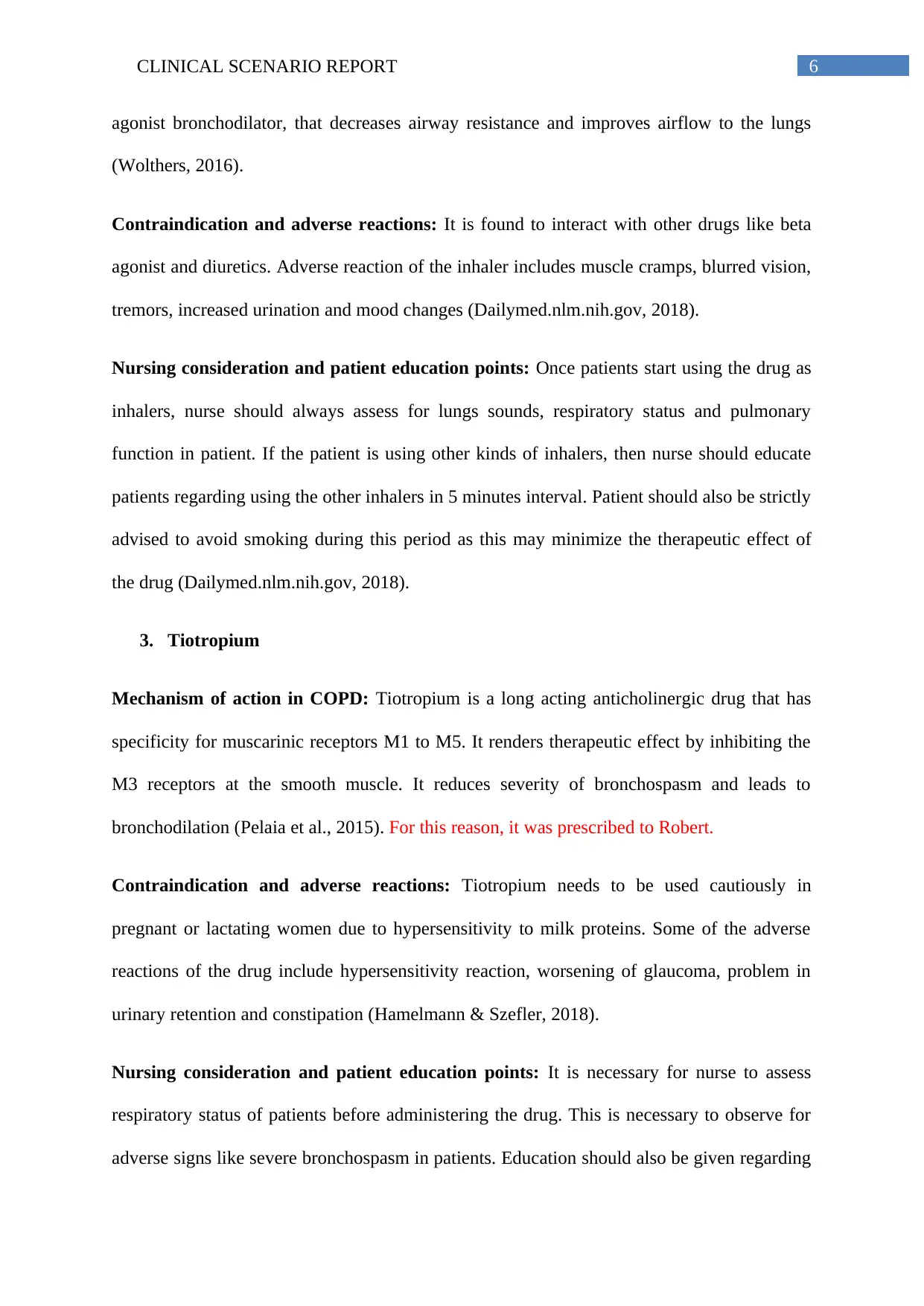
6CLINICAL SCENARIO REPORT
agonist bronchodilator, that decreases airway resistance and improves airflow to the lungs
(Wolthers, 2016).
Contraindication and adverse reactions: It is found to interact with other drugs like beta
agonist and diuretics. Adverse reaction of the inhaler includes muscle cramps, blurred vision,
tremors, increased urination and mood changes (Dailymed.nlm.nih.gov, 2018).
Nursing consideration and patient education points: Once patients start using the drug as
inhalers, nurse should always assess for lungs sounds, respiratory status and pulmonary
function in patient. If the patient is using other kinds of inhalers, then nurse should educate
patients regarding using the other inhalers in 5 minutes interval. Patient should also be strictly
advised to avoid smoking during this period as this may minimize the therapeutic effect of
the drug (Dailymed.nlm.nih.gov, 2018).
3. Tiotropium
Mechanism of action in COPD: Tiotropium is a long acting anticholinergic drug that has
specificity for muscarinic receptors M1 to M5. It renders therapeutic effect by inhibiting the
M3 receptors at the smooth muscle. It reduces severity of bronchospasm and leads to
bronchodilation (Pelaia et al., 2015). For this reason, it was prescribed to Robert.
Contraindication and adverse reactions: Tiotropium needs to be used cautiously in
pregnant or lactating women due to hypersensitivity to milk proteins. Some of the adverse
reactions of the drug include hypersensitivity reaction, worsening of glaucoma, problem in
urinary retention and constipation (Hamelmann & Szefler, 2018).
Nursing consideration and patient education points: It is necessary for nurse to assess
respiratory status of patients before administering the drug. This is necessary to observe for
adverse signs like severe bronchospasm in patients. Education should also be given regarding
agonist bronchodilator, that decreases airway resistance and improves airflow to the lungs
(Wolthers, 2016).
Contraindication and adverse reactions: It is found to interact with other drugs like beta
agonist and diuretics. Adverse reaction of the inhaler includes muscle cramps, blurred vision,
tremors, increased urination and mood changes (Dailymed.nlm.nih.gov, 2018).
Nursing consideration and patient education points: Once patients start using the drug as
inhalers, nurse should always assess for lungs sounds, respiratory status and pulmonary
function in patient. If the patient is using other kinds of inhalers, then nurse should educate
patients regarding using the other inhalers in 5 minutes interval. Patient should also be strictly
advised to avoid smoking during this period as this may minimize the therapeutic effect of
the drug (Dailymed.nlm.nih.gov, 2018).
3. Tiotropium
Mechanism of action in COPD: Tiotropium is a long acting anticholinergic drug that has
specificity for muscarinic receptors M1 to M5. It renders therapeutic effect by inhibiting the
M3 receptors at the smooth muscle. It reduces severity of bronchospasm and leads to
bronchodilation (Pelaia et al., 2015). For this reason, it was prescribed to Robert.
Contraindication and adverse reactions: Tiotropium needs to be used cautiously in
pregnant or lactating women due to hypersensitivity to milk proteins. Some of the adverse
reactions of the drug include hypersensitivity reaction, worsening of glaucoma, problem in
urinary retention and constipation (Hamelmann & Szefler, 2018).
Nursing consideration and patient education points: It is necessary for nurse to assess
respiratory status of patients before administering the drug. This is necessary to observe for
adverse signs like severe bronchospasm in patients. Education should also be given regarding
Paraphrase This Document
Need a fresh take? Get an instant paraphrase of this document with our AI Paraphraser

7CLINICAL SCENARIO REPORT
ways to use the drug and immediately notifying to clinical when swelling of lip and throat
itching is found after inhaling the drug (Lyseng-Williamson & Keating, 2015).
The respiratory physician might have changed Robert’s medication regime because of
observation of side effects like that of worsening asthma symptom and wheeziness in patient.
The advantage of tiotropium over Budesonide/Efomoterol fumarate dehydrate is that it works
to reduces acute exacerbation in COPD patient and has long terms benefits in preventing
hospitalization in patients too (Buhl et al., 2017).
2.2 Three antibiotics that could be used to treat Streptococcus pneumoniae in Robert’s case:
Robert was diagnosed with CAP and it was found that Streptococcus pneumonia was the
main pathogen behind CAP. Three antibiotics that can be given to Robert to treat
Streptococcus pneumoniae include the following:
1. Ceftriaxone:
Mechanism of action: Ceftriaxone is an antibiotic mainly given for treatment of
pneumococcal infection caused by S. Pneumoniae. The therapeutic action of the drug is seen
due to its role in inhibiting the synthesis of bacterial cell wall by binding to the
transpeptidase. This kind of inhibition leads to the damage of bacterial cell wall and
ultimately cell death (Pubchem.ncbi.nlm.nih.gov, 2018). .
Contraindication and adverse reactions: Ceftriaxone shows hypersensitivity to cephalosporin
and penicillin. Seizure, diaarhea, rashes and haemolytic anemia are some adverse reactions
associated with the drug (Pubchem.ncbi.nlm.nih.gov, 2018).
Nursing consideration and patient education: Throughout the antibiotic therapy, nurse must
assess patients for signs of infection by means of vital sign assessment, sputum check and
ways to use the drug and immediately notifying to clinical when swelling of lip and throat
itching is found after inhaling the drug (Lyseng-Williamson & Keating, 2015).
The respiratory physician might have changed Robert’s medication regime because of
observation of side effects like that of worsening asthma symptom and wheeziness in patient.
The advantage of tiotropium over Budesonide/Efomoterol fumarate dehydrate is that it works
to reduces acute exacerbation in COPD patient and has long terms benefits in preventing
hospitalization in patients too (Buhl et al., 2017).
2.2 Three antibiotics that could be used to treat Streptococcus pneumoniae in Robert’s case:
Robert was diagnosed with CAP and it was found that Streptococcus pneumonia was the
main pathogen behind CAP. Three antibiotics that can be given to Robert to treat
Streptococcus pneumoniae include the following:
1. Ceftriaxone:
Mechanism of action: Ceftriaxone is an antibiotic mainly given for treatment of
pneumococcal infection caused by S. Pneumoniae. The therapeutic action of the drug is seen
due to its role in inhibiting the synthesis of bacterial cell wall by binding to the
transpeptidase. This kind of inhibition leads to the damage of bacterial cell wall and
ultimately cell death (Pubchem.ncbi.nlm.nih.gov, 2018). .
Contraindication and adverse reactions: Ceftriaxone shows hypersensitivity to cephalosporin
and penicillin. Seizure, diaarhea, rashes and haemolytic anemia are some adverse reactions
associated with the drug (Pubchem.ncbi.nlm.nih.gov, 2018).
Nursing consideration and patient education: Throughout the antibiotic therapy, nurse must
assess patients for signs of infection by means of vital sign assessment, sputum check and

8CLINICAL SCENARIO REPORT
trackings changes in WBC. While continuing the therapy, signs of adverse reactions and
symptoms of anaphylaxis must also be checked by nurses (Kizior et al., 2018).
2. Rifampin
Mechanism of action: Rifampin acts to inhibit the action of RNA polymerase and preventing
RNA synthesis thus prevention the development of bacterial proteins. This kind of
bactericidal action prevents infections caused by Streptococcus pneumoniae (Vallerand,
Sanoski & Deglin, 2016). .
Contraindication and adverse reactions: The drug should be used with precaution when
patient is taking drugs like atazanavir, tipranavir or saquinavir. Fatigue, diarhhea, abdominal
pain and haemolytic anaemia are some adverse reactions of the drug.
Nursing consideration and patient education: During the therapy, susceptibility test should
be done to identify resistance. Nurse should also assess lung sounds and characteristics of
sputum and observe for side effects of the drug in patient. Patient education is mainly
required in the area of notifying patients about the side effects and reporting about it as soon
as possible (Kee, Hayes & McCuistion, 2014).
3. Vancomycine
Mechanism of action: Vancomycin acts against gram positive bacteria and prevent
biosynthesis of bacterial cell wall by binding to the N-acetylmuramic acid and N-
acetylglucosamine of the peptidoglycan. This weakens the peptidoglycan layer and more
permeable resulting in leakage of the cell content and ultimately bacterial death (Satoskar,
Rege & Bhandarkar, 2015).
Contraindication and adverse reactions: The use of vancomycin is associated with side
effects like rashes, hypersensitivity, nausea, back and neck pain. The drug should be used
trackings changes in WBC. While continuing the therapy, signs of adverse reactions and
symptoms of anaphylaxis must also be checked by nurses (Kizior et al., 2018).
2. Rifampin
Mechanism of action: Rifampin acts to inhibit the action of RNA polymerase and preventing
RNA synthesis thus prevention the development of bacterial proteins. This kind of
bactericidal action prevents infections caused by Streptococcus pneumoniae (Vallerand,
Sanoski & Deglin, 2016). .
Contraindication and adverse reactions: The drug should be used with precaution when
patient is taking drugs like atazanavir, tipranavir or saquinavir. Fatigue, diarhhea, abdominal
pain and haemolytic anaemia are some adverse reactions of the drug.
Nursing consideration and patient education: During the therapy, susceptibility test should
be done to identify resistance. Nurse should also assess lung sounds and characteristics of
sputum and observe for side effects of the drug in patient. Patient education is mainly
required in the area of notifying patients about the side effects and reporting about it as soon
as possible (Kee, Hayes & McCuistion, 2014).
3. Vancomycine
Mechanism of action: Vancomycin acts against gram positive bacteria and prevent
biosynthesis of bacterial cell wall by binding to the N-acetylmuramic acid and N-
acetylglucosamine of the peptidoglycan. This weakens the peptidoglycan layer and more
permeable resulting in leakage of the cell content and ultimately bacterial death (Satoskar,
Rege & Bhandarkar, 2015).
Contraindication and adverse reactions: The use of vancomycin is associated with side
effects like rashes, hypersensitivity, nausea, back and neck pain. The drug should be used
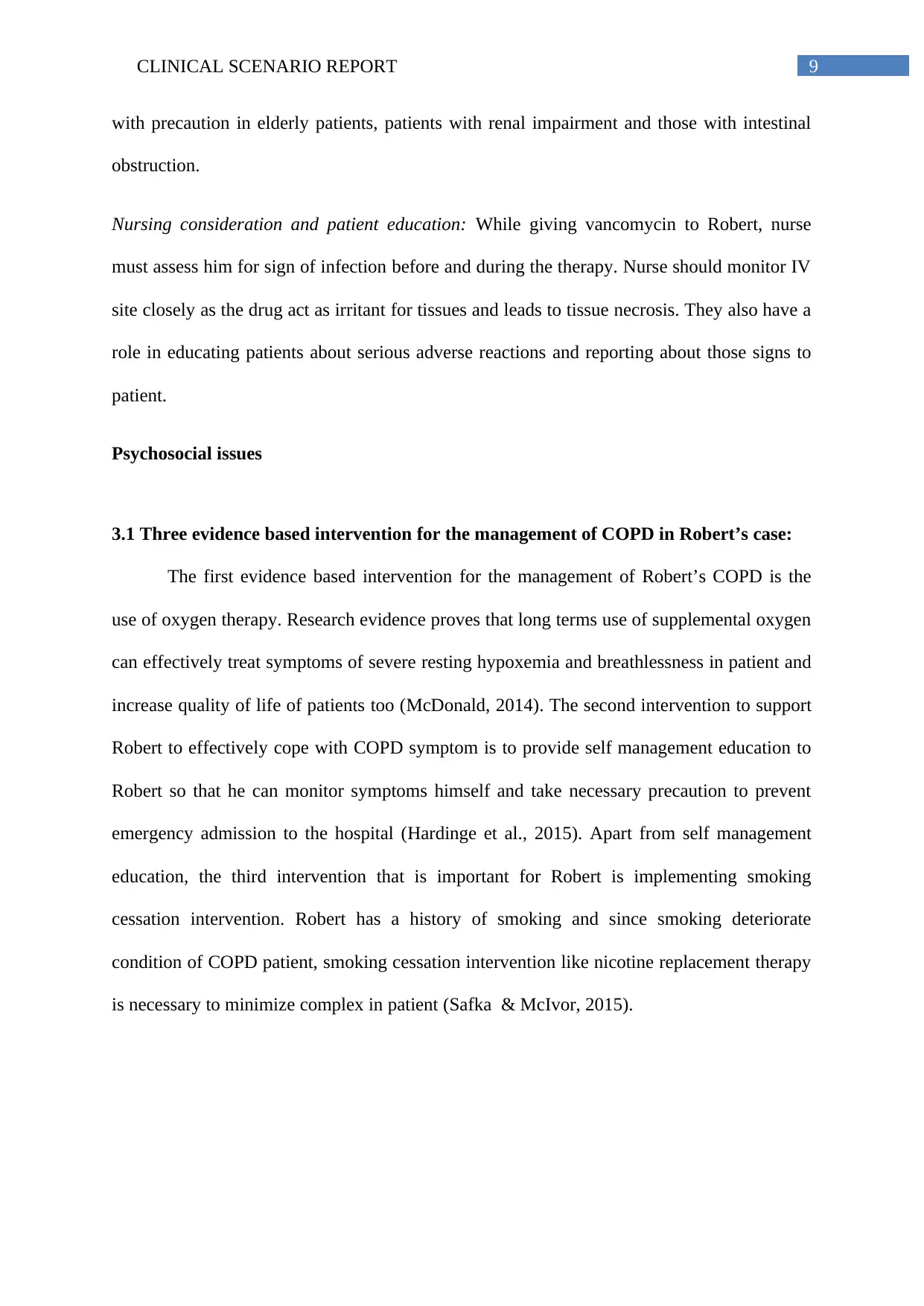
9CLINICAL SCENARIO REPORT
with precaution in elderly patients, patients with renal impairment and those with intestinal
obstruction.
Nursing consideration and patient education: While giving vancomycin to Robert, nurse
must assess him for sign of infection before and during the therapy. Nurse should monitor IV
site closely as the drug act as irritant for tissues and leads to tissue necrosis. They also have a
role in educating patients about serious adverse reactions and reporting about those signs to
patient.
Psychosocial issues
3.1 Three evidence based intervention for the management of COPD in Robert’s case:
The first evidence based intervention for the management of Robert’s COPD is the
use of oxygen therapy. Research evidence proves that long terms use of supplemental oxygen
can effectively treat symptoms of severe resting hypoxemia and breathlessness in patient and
increase quality of life of patients too (McDonald, 2014). The second intervention to support
Robert to effectively cope with COPD symptom is to provide self management education to
Robert so that he can monitor symptoms himself and take necessary precaution to prevent
emergency admission to the hospital (Hardinge et al., 2015). Apart from self management
education, the third intervention that is important for Robert is implementing smoking
cessation intervention. Robert has a history of smoking and since smoking deteriorate
condition of COPD patient, smoking cessation intervention like nicotine replacement therapy
is necessary to minimize complex in patient (Safka & McIvor, 2015).
with precaution in elderly patients, patients with renal impairment and those with intestinal
obstruction.
Nursing consideration and patient education: While giving vancomycin to Robert, nurse
must assess him for sign of infection before and during the therapy. Nurse should monitor IV
site closely as the drug act as irritant for tissues and leads to tissue necrosis. They also have a
role in educating patients about serious adverse reactions and reporting about those signs to
patient.
Psychosocial issues
3.1 Three evidence based intervention for the management of COPD in Robert’s case:
The first evidence based intervention for the management of Robert’s COPD is the
use of oxygen therapy. Research evidence proves that long terms use of supplemental oxygen
can effectively treat symptoms of severe resting hypoxemia and breathlessness in patient and
increase quality of life of patients too (McDonald, 2014). The second intervention to support
Robert to effectively cope with COPD symptom is to provide self management education to
Robert so that he can monitor symptoms himself and take necessary precaution to prevent
emergency admission to the hospital (Hardinge et al., 2015). Apart from self management
education, the third intervention that is important for Robert is implementing smoking
cessation intervention. Robert has a history of smoking and since smoking deteriorate
condition of COPD patient, smoking cessation intervention like nicotine replacement therapy
is necessary to minimize complex in patient (Safka & McIvor, 2015).
Secure Best Marks with AI Grader
Need help grading? Try our AI Grader for instant feedback on your assignments.
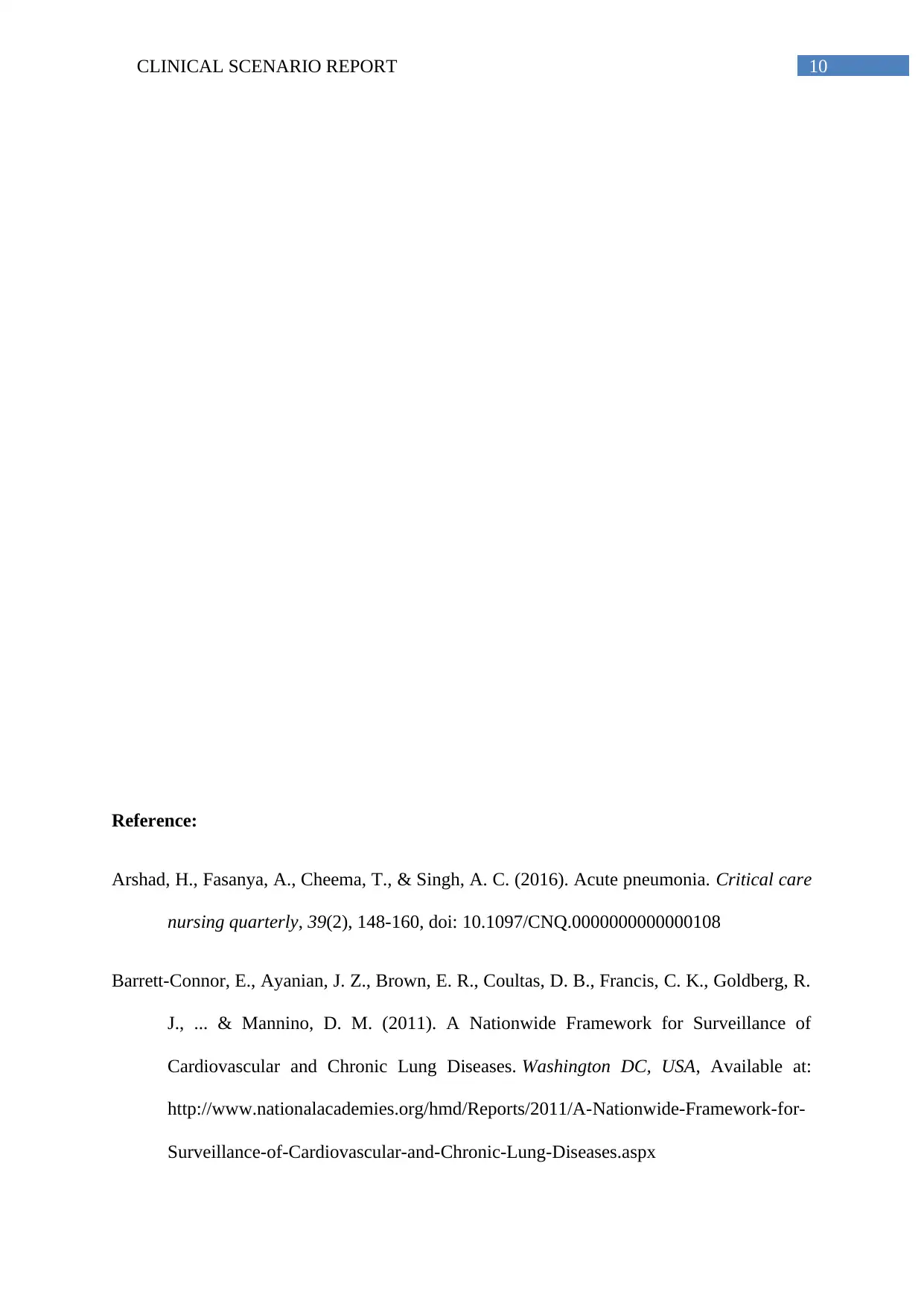
10CLINICAL SCENARIO REPORT
Reference:
Arshad, H., Fasanya, A., Cheema, T., & Singh, A. C. (2016). Acute pneumonia. Critical care
nursing quarterly, 39(2), 148-160, doi: 10.1097/CNQ.0000000000000108
Barrett-Connor, E., Ayanian, J. Z., Brown, E. R., Coultas, D. B., Francis, C. K., Goldberg, R.
J., ... & Mannino, D. M. (2011). A Nationwide Framework for Surveillance of
Cardiovascular and Chronic Lung Diseases. Washington DC, USA, Available at:
http://www.nationalacademies.org/hmd/Reports/2011/A-Nationwide-Framework-for-
Surveillance-of-Cardiovascular-and-Chronic-Lung-Diseases.aspx
Reference:
Arshad, H., Fasanya, A., Cheema, T., & Singh, A. C. (2016). Acute pneumonia. Critical care
nursing quarterly, 39(2), 148-160, doi: 10.1097/CNQ.0000000000000108
Barrett-Connor, E., Ayanian, J. Z., Brown, E. R., Coultas, D. B., Francis, C. K., Goldberg, R.
J., ... & Mannino, D. M. (2011). A Nationwide Framework for Surveillance of
Cardiovascular and Chronic Lung Diseases. Washington DC, USA, Available at:
http://www.nationalacademies.org/hmd/Reports/2011/A-Nationwide-Framework-for-
Surveillance-of-Cardiovascular-and-Chronic-Lung-Diseases.aspx

11CLINICAL SCENARIO REPORT
Brashier, B. B., & Kodgule, R. (2012). Risk factors and pathophysiology of chronic
obstructive pulmonary disease (COPD). J Assoc Physicians India, 60(Suppl), 17-21,
Available at:
https://pdfs.semanticscholar.org/517c/439f8badef329dc35d5569d433e550470bf2.pdf
Buhl, R., McGarvey, L., Korn, S., Ferguson, G. T., Grönke, L., Hallmann, C., ... & Maltais,
F. (2017). Benefits of Tiotropium+ Olodaterol Over Tiotropium at Delaying
Clinically Significant Events in Patients with COPD Classified as GOLD
B. Pneumologie, 71(S 01), P240, Available at:
https://www.atsjournals.org/doi/pdf/10.1164/ajrccm-
conference.2016.193.1_MeetingAbstracts.A6779
Dailymed.nlm.nih.gov. (2018). DailyMed - SYMBICORT- budesonide and formoterol
fumarate dihydrate aerosol. Retrieved 4 March 2018, from
https://dailymed.nlm.nih.gov/dailymed/drugInfo.cfm?setid=fafa4cf1-99c2-43d5-
73ad-51f256de3be0
Hamelmann, E., & Szefler, S. J. (2018). Efficacy and Safety of Tiotropium in Children and
Adolescents. Drugs, 1-12, Available at:
https://link.springer.com/article/10.1007/s40265-018-0862-1
Hardinge, M., Rutter, H., Velardo, C., Shah, S. A., Williams, V., Tarassenko, L., & Farmer,
A. (2015). Using a mobile health application to support self-management in chronic
obstructive pulmonary disease: a six-month cohort study. BMC medical informatics
and decision making, 15(1), 46, doi: https://doi.org/10.1186/s12911-015-0171-5
Kalil, A. C., Metersky, M. L., Klompas, M., Muscedere, J., Sweeney, D. A., Palmer, L. B., ...
& El Solh, A. A. (2016). Management of adults with hospital-acquired and ventilator-
Brashier, B. B., & Kodgule, R. (2012). Risk factors and pathophysiology of chronic
obstructive pulmonary disease (COPD). J Assoc Physicians India, 60(Suppl), 17-21,
Available at:
https://pdfs.semanticscholar.org/517c/439f8badef329dc35d5569d433e550470bf2.pdf
Buhl, R., McGarvey, L., Korn, S., Ferguson, G. T., Grönke, L., Hallmann, C., ... & Maltais,
F. (2017). Benefits of Tiotropium+ Olodaterol Over Tiotropium at Delaying
Clinically Significant Events in Patients with COPD Classified as GOLD
B. Pneumologie, 71(S 01), P240, Available at:
https://www.atsjournals.org/doi/pdf/10.1164/ajrccm-
conference.2016.193.1_MeetingAbstracts.A6779
Dailymed.nlm.nih.gov. (2018). DailyMed - SYMBICORT- budesonide and formoterol
fumarate dihydrate aerosol. Retrieved 4 March 2018, from
https://dailymed.nlm.nih.gov/dailymed/drugInfo.cfm?setid=fafa4cf1-99c2-43d5-
73ad-51f256de3be0
Hamelmann, E., & Szefler, S. J. (2018). Efficacy and Safety of Tiotropium in Children and
Adolescents. Drugs, 1-12, Available at:
https://link.springer.com/article/10.1007/s40265-018-0862-1
Hardinge, M., Rutter, H., Velardo, C., Shah, S. A., Williams, V., Tarassenko, L., & Farmer,
A. (2015). Using a mobile health application to support self-management in chronic
obstructive pulmonary disease: a six-month cohort study. BMC medical informatics
and decision making, 15(1), 46, doi: https://doi.org/10.1186/s12911-015-0171-5
Kalil, A. C., Metersky, M. L., Klompas, M., Muscedere, J., Sweeney, D. A., Palmer, L. B., ...
& El Solh, A. A. (2016). Management of adults with hospital-acquired and ventilator-

12CLINICAL SCENARIO REPORT
associated pneumonia: 2016 clinical practice guidelines by the Infectious Diseases
Society of America and the American Thoracic Society. Clinical Infectious
Diseases, 63(5), e61-e111, Doi: 10.1093/cid/ciw353
Kee, J. L., Hayes, E. R., & McCuistion, L. E. (2014). Pharmacology-E-Book: A Patient-
Centered Nursing Process Approach. Elsevier Health Sciences, Available at:
https://books.google.co.in/books?
hl=en&lr=&id=abnwAwAAQBAJ&oi=fnd&pg=PP1&dq=Pharmacology-E-Book:
+A+Patient-
Centered+Nursing+Process+Approach.&ots=pHeNn63UoX&sig=PrSEQiT_uee8nYn
DGhJs9rGAGAc#v=onepage&q=Pharmacology-E-Book%3A%20A%20Patient-
Centered%20Nursing%20Process%20Approach.&f=false
Kizior, R. J., Rph, B., Hodgson, B. B., & Ocn, R. N. (2018). Saunders Nursing Drug
Handbook 2019 E-Book. Elsevier Health Sciences, Available at:
https://books.google.co.in/books?
hl=en&lr=&id=eJNNDwAAQBAJ&oi=fnd&pg=PP1&dq=Saunders+Nursing+Drug+
Handbook+2019+E-Book.&ots=6LlvOz8zez&sig=i8YMfYdscCCtEczi5f-
paaSWeKw#v=onepage&q=Saunders%20Nursing%20Drug%20Handbook
%202019%20E-Book.&f=false
Ko, F. W., Chan, K. P., Hui, D. S., Goddard, J. R., Shaw, J. G., Reid, D. W., & Yang, I. A.
(2016). Acute exacerbation of COPD. Respirology, 21(7), 1152-1165, Doi:
10.1111/resp.12780
Lin, S. H., Perng, D. W., Chen, C. P., Chai, W. H., Yeh, C. S., Kor, C. T., ... & Lin, C. H.
(2016). Increased risk of community-acquired pneumonia in COPD patients with
associated pneumonia: 2016 clinical practice guidelines by the Infectious Diseases
Society of America and the American Thoracic Society. Clinical Infectious
Diseases, 63(5), e61-e111, Doi: 10.1093/cid/ciw353
Kee, J. L., Hayes, E. R., & McCuistion, L. E. (2014). Pharmacology-E-Book: A Patient-
Centered Nursing Process Approach. Elsevier Health Sciences, Available at:
https://books.google.co.in/books?
hl=en&lr=&id=abnwAwAAQBAJ&oi=fnd&pg=PP1&dq=Pharmacology-E-Book:
+A+Patient-
Centered+Nursing+Process+Approach.&ots=pHeNn63UoX&sig=PrSEQiT_uee8nYn
DGhJs9rGAGAc#v=onepage&q=Pharmacology-E-Book%3A%20A%20Patient-
Centered%20Nursing%20Process%20Approach.&f=false
Kizior, R. J., Rph, B., Hodgson, B. B., & Ocn, R. N. (2018). Saunders Nursing Drug
Handbook 2019 E-Book. Elsevier Health Sciences, Available at:
https://books.google.co.in/books?
hl=en&lr=&id=eJNNDwAAQBAJ&oi=fnd&pg=PP1&dq=Saunders+Nursing+Drug+
Handbook+2019+E-Book.&ots=6LlvOz8zez&sig=i8YMfYdscCCtEczi5f-
paaSWeKw#v=onepage&q=Saunders%20Nursing%20Drug%20Handbook
%202019%20E-Book.&f=false
Ko, F. W., Chan, K. P., Hui, D. S., Goddard, J. R., Shaw, J. G., Reid, D. W., & Yang, I. A.
(2016). Acute exacerbation of COPD. Respirology, 21(7), 1152-1165, Doi:
10.1111/resp.12780
Lin, S. H., Perng, D. W., Chen, C. P., Chai, W. H., Yeh, C. S., Kor, C. T., ... & Lin, C. H.
(2016). Increased risk of community-acquired pneumonia in COPD patients with
Paraphrase This Document
Need a fresh take? Get an instant paraphrase of this document with our AI Paraphraser
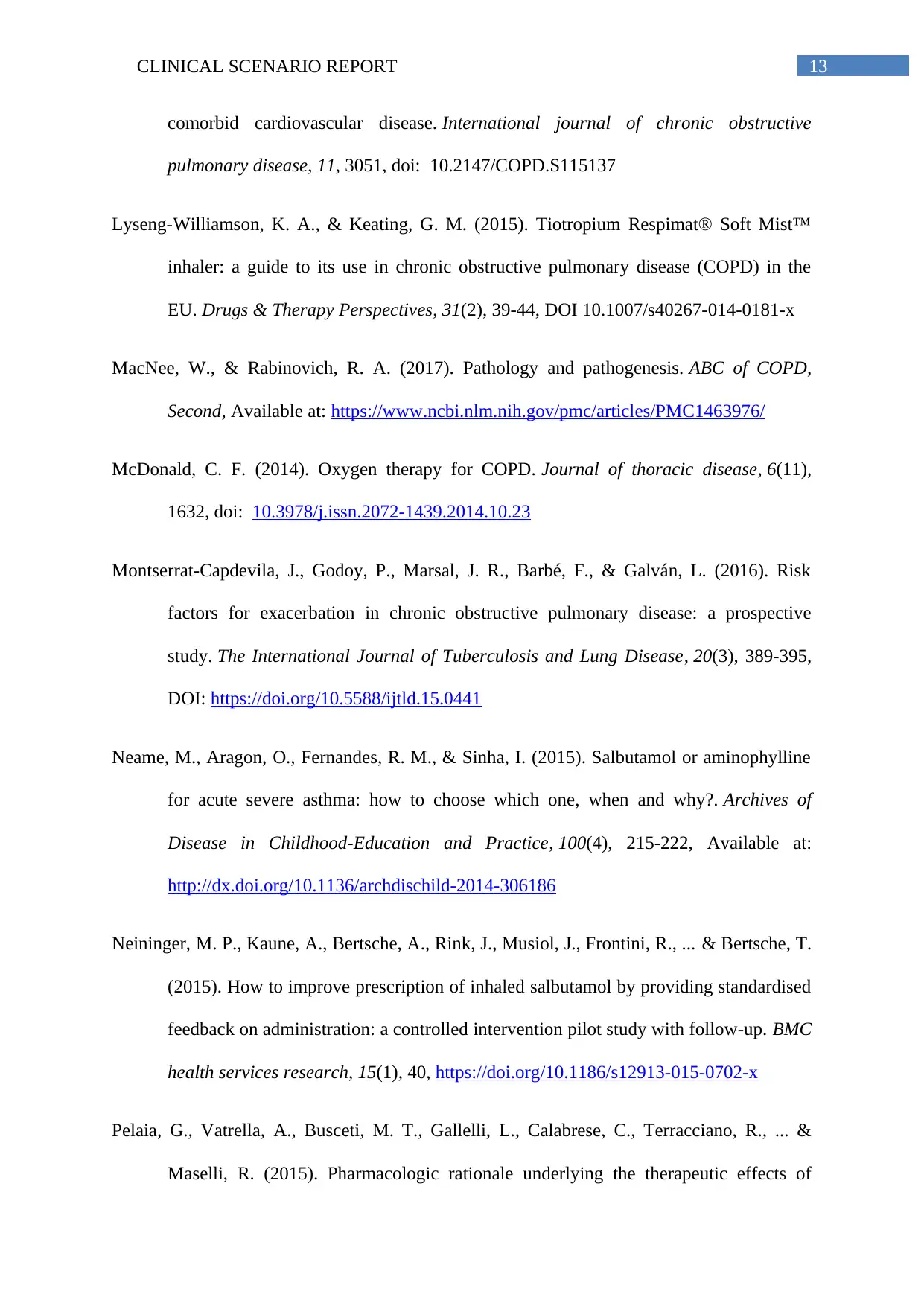
13CLINICAL SCENARIO REPORT
comorbid cardiovascular disease. International journal of chronic obstructive
pulmonary disease, 11, 3051, doi: 10.2147/COPD.S115137
Lyseng-Williamson, K. A., & Keating, G. M. (2015). Tiotropium Respimat® Soft Mist™
inhaler: a guide to its use in chronic obstructive pulmonary disease (COPD) in the
EU. Drugs & Therapy Perspectives, 31(2), 39-44, DOI 10.1007/s40267-014-0181-x
MacNee, W., & Rabinovich, R. A. (2017). Pathology and pathogenesis. ABC of COPD,
Second, Available at: https://www.ncbi.nlm.nih.gov/pmc/articles/PMC1463976/
McDonald, C. F. (2014). Oxygen therapy for COPD. Journal of thoracic disease, 6(11),
1632, doi: 10.3978/j.issn.2072-1439.2014.10.23
Montserrat-Capdevila, J., Godoy, P., Marsal, J. R., Barbé, F., & Galván, L. (2016). Risk
factors for exacerbation in chronic obstructive pulmonary disease: a prospective
study. The International Journal of Tuberculosis and Lung Disease, 20(3), 389-395,
DOI: https://doi.org/10.5588/ijtld.15.0441
Neame, M., Aragon, O., Fernandes, R. M., & Sinha, I. (2015). Salbutamol or aminophylline
for acute severe asthma: how to choose which one, when and why?. Archives of
Disease in Childhood-Education and Practice, 100(4), 215-222, Available at:
http://dx.doi.org/10.1136/archdischild-2014-306186
Neininger, M. P., Kaune, A., Bertsche, A., Rink, J., Musiol, J., Frontini, R., ... & Bertsche, T.
(2015). How to improve prescription of inhaled salbutamol by providing standardised
feedback on administration: a controlled intervention pilot study with follow-up. BMC
health services research, 15(1), 40, https://doi.org/10.1186/s12913-015-0702-x
Pelaia, G., Vatrella, A., Busceti, M. T., Gallelli, L., Calabrese, C., Terracciano, R., ... &
Maselli, R. (2015). Pharmacologic rationale underlying the therapeutic effects of
comorbid cardiovascular disease. International journal of chronic obstructive
pulmonary disease, 11, 3051, doi: 10.2147/COPD.S115137
Lyseng-Williamson, K. A., & Keating, G. M. (2015). Tiotropium Respimat® Soft Mist™
inhaler: a guide to its use in chronic obstructive pulmonary disease (COPD) in the
EU. Drugs & Therapy Perspectives, 31(2), 39-44, DOI 10.1007/s40267-014-0181-x
MacNee, W., & Rabinovich, R. A. (2017). Pathology and pathogenesis. ABC of COPD,
Second, Available at: https://www.ncbi.nlm.nih.gov/pmc/articles/PMC1463976/
McDonald, C. F. (2014). Oxygen therapy for COPD. Journal of thoracic disease, 6(11),
1632, doi: 10.3978/j.issn.2072-1439.2014.10.23
Montserrat-Capdevila, J., Godoy, P., Marsal, J. R., Barbé, F., & Galván, L. (2016). Risk
factors for exacerbation in chronic obstructive pulmonary disease: a prospective
study. The International Journal of Tuberculosis and Lung Disease, 20(3), 389-395,
DOI: https://doi.org/10.5588/ijtld.15.0441
Neame, M., Aragon, O., Fernandes, R. M., & Sinha, I. (2015). Salbutamol or aminophylline
for acute severe asthma: how to choose which one, when and why?. Archives of
Disease in Childhood-Education and Practice, 100(4), 215-222, Available at:
http://dx.doi.org/10.1136/archdischild-2014-306186
Neininger, M. P., Kaune, A., Bertsche, A., Rink, J., Musiol, J., Frontini, R., ... & Bertsche, T.
(2015). How to improve prescription of inhaled salbutamol by providing standardised
feedback on administration: a controlled intervention pilot study with follow-up. BMC
health services research, 15(1), 40, https://doi.org/10.1186/s12913-015-0702-x
Pelaia, G., Vatrella, A., Busceti, M. T., Gallelli, L., Calabrese, C., Terracciano, R., ... &
Maselli, R. (2015). Pharmacologic rationale underlying the therapeutic effects of
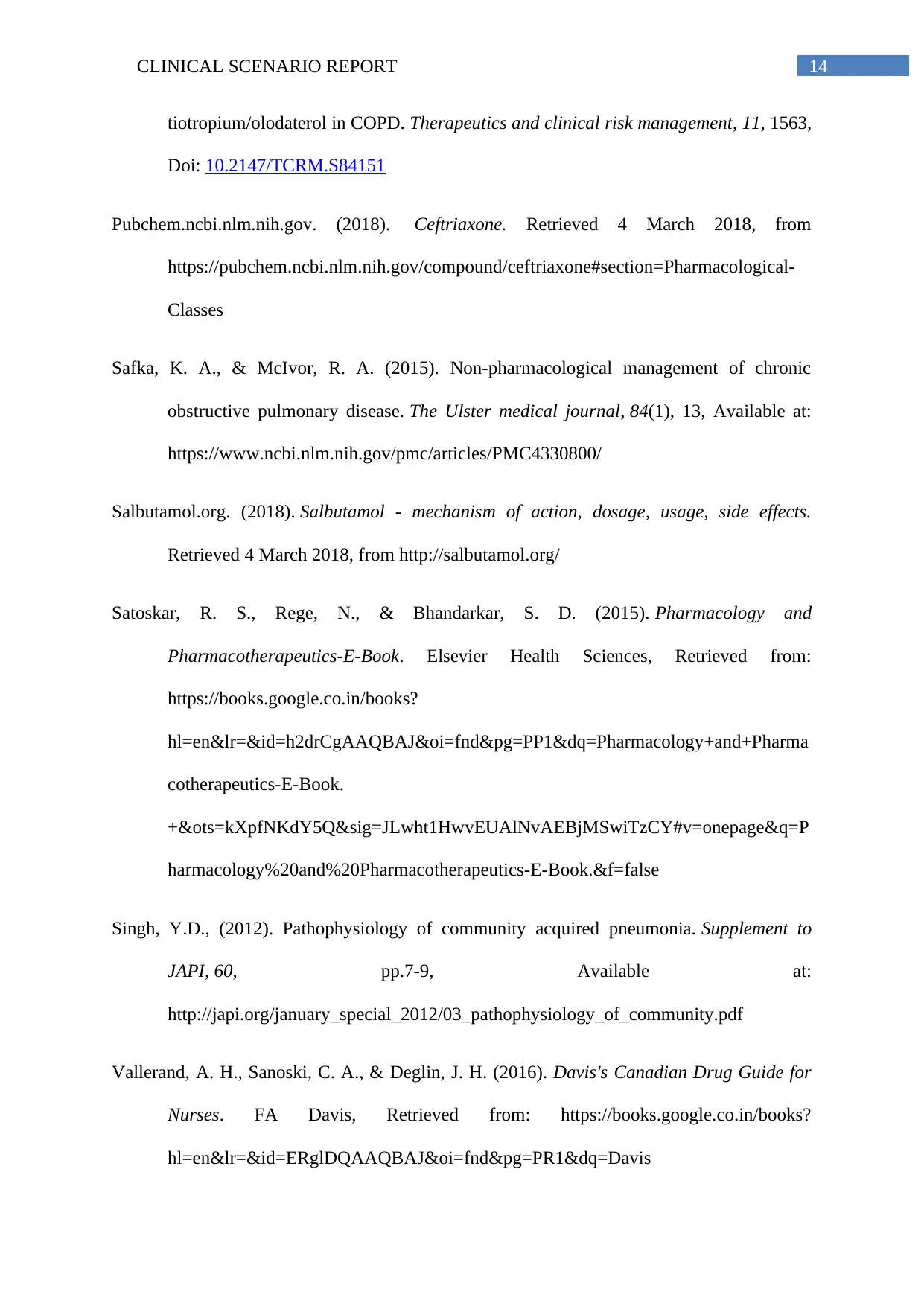
14CLINICAL SCENARIO REPORT
tiotropium/olodaterol in COPD. Therapeutics and clinical risk management, 11, 1563,
Doi: 10.2147/TCRM.S84151
Pubchem.ncbi.nlm.nih.gov. (2018). Ceftriaxone. Retrieved 4 March 2018, from
https://pubchem.ncbi.nlm.nih.gov/compound/ceftriaxone#section=Pharmacological-
Classes
Safka, K. A., & McIvor, R. A. (2015). Non-pharmacological management of chronic
obstructive pulmonary disease. The Ulster medical journal, 84(1), 13, Available at:
https://www.ncbi.nlm.nih.gov/pmc/articles/PMC4330800/
Salbutamol.org. (2018). Salbutamol - mechanism of action, dosage, usage, side effects.
Retrieved 4 March 2018, from http://salbutamol.org/
Satoskar, R. S., Rege, N., & Bhandarkar, S. D. (2015). Pharmacology and
Pharmacotherapeutics-E-Book. Elsevier Health Sciences, Retrieved from:
https://books.google.co.in/books?
hl=en&lr=&id=h2drCgAAQBAJ&oi=fnd&pg=PP1&dq=Pharmacology+and+Pharma
cotherapeutics-E-Book.
+&ots=kXpfNKdY5Q&sig=JLwht1HwvEUAlNvAEBjMSwiTzCY#v=onepage&q=P
harmacology%20and%20Pharmacotherapeutics-E-Book.&f=false
Singh, Y.D., (2012). Pathophysiology of community acquired pneumonia. Supplement to
JAPI, 60, pp.7-9, Available at:
http://japi.org/january_special_2012/03_pathophysiology_of_community.pdf
Vallerand, A. H., Sanoski, C. A., & Deglin, J. H. (2016). Davis's Canadian Drug Guide for
Nurses. FA Davis, Retrieved from: https://books.google.co.in/books?
hl=en&lr=&id=ERglDQAAQBAJ&oi=fnd&pg=PR1&dq=Davis
tiotropium/olodaterol in COPD. Therapeutics and clinical risk management, 11, 1563,
Doi: 10.2147/TCRM.S84151
Pubchem.ncbi.nlm.nih.gov. (2018). Ceftriaxone. Retrieved 4 March 2018, from
https://pubchem.ncbi.nlm.nih.gov/compound/ceftriaxone#section=Pharmacological-
Classes
Safka, K. A., & McIvor, R. A. (2015). Non-pharmacological management of chronic
obstructive pulmonary disease. The Ulster medical journal, 84(1), 13, Available at:
https://www.ncbi.nlm.nih.gov/pmc/articles/PMC4330800/
Salbutamol.org. (2018). Salbutamol - mechanism of action, dosage, usage, side effects.
Retrieved 4 March 2018, from http://salbutamol.org/
Satoskar, R. S., Rege, N., & Bhandarkar, S. D. (2015). Pharmacology and
Pharmacotherapeutics-E-Book. Elsevier Health Sciences, Retrieved from:
https://books.google.co.in/books?
hl=en&lr=&id=h2drCgAAQBAJ&oi=fnd&pg=PP1&dq=Pharmacology+and+Pharma
cotherapeutics-E-Book.
+&ots=kXpfNKdY5Q&sig=JLwht1HwvEUAlNvAEBjMSwiTzCY#v=onepage&q=P
harmacology%20and%20Pharmacotherapeutics-E-Book.&f=false
Singh, Y.D., (2012). Pathophysiology of community acquired pneumonia. Supplement to
JAPI, 60, pp.7-9, Available at:
http://japi.org/january_special_2012/03_pathophysiology_of_community.pdf
Vallerand, A. H., Sanoski, C. A., & Deglin, J. H. (2016). Davis's Canadian Drug Guide for
Nurses. FA Davis, Retrieved from: https://books.google.co.in/books?
hl=en&lr=&id=ERglDQAAQBAJ&oi=fnd&pg=PR1&dq=Davis
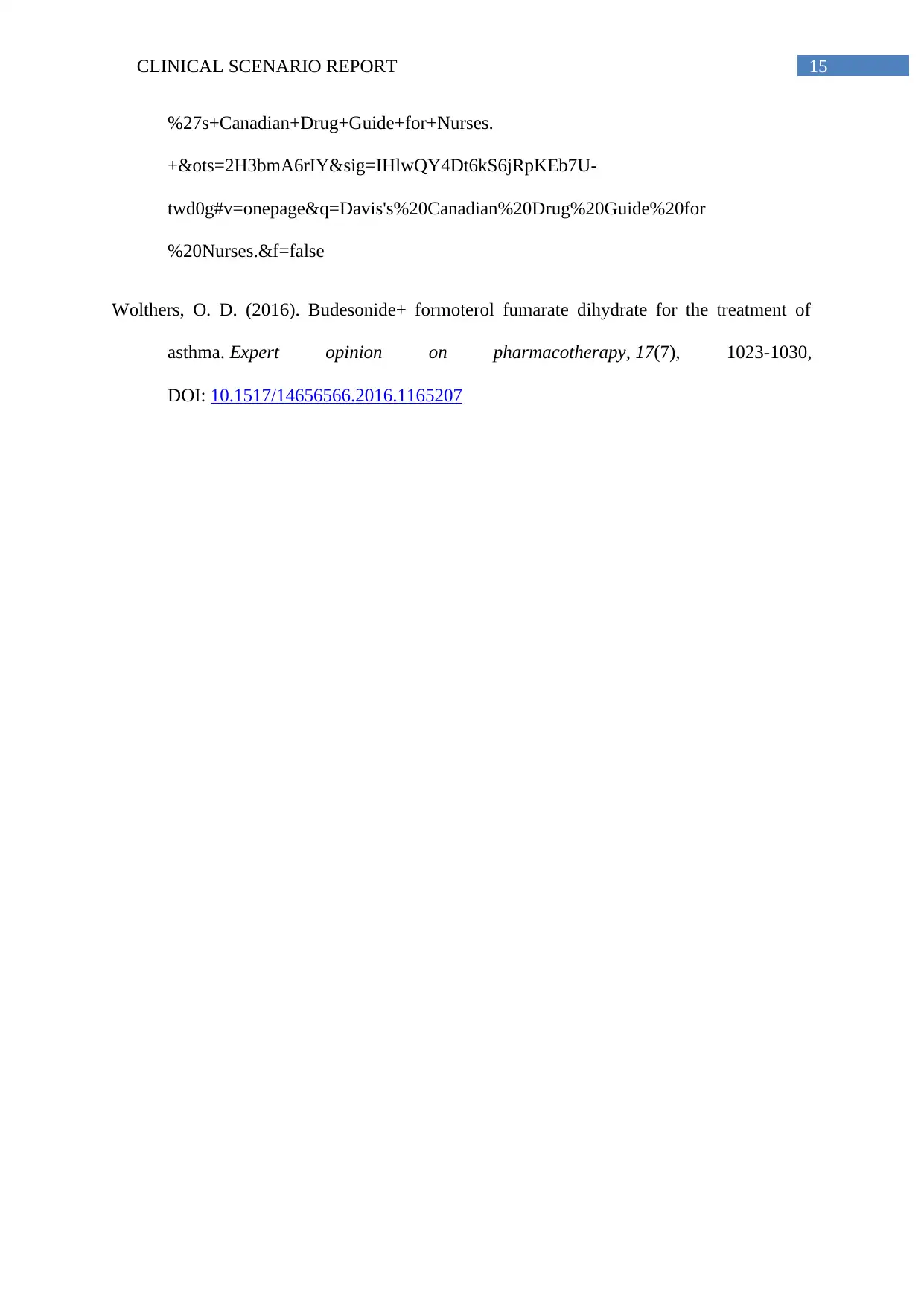
15CLINICAL SCENARIO REPORT
%27s+Canadian+Drug+Guide+for+Nurses.
+&ots=2H3bmA6rIY&sig=IHlwQY4Dt6kS6jRpKEb7U-
twd0g#v=onepage&q=Davis's%20Canadian%20Drug%20Guide%20for
%20Nurses.&f=false
Wolthers, O. D. (2016). Budesonide+ formoterol fumarate dihydrate for the treatment of
asthma. Expert opinion on pharmacotherapy, 17(7), 1023-1030,
DOI: 10.1517/14656566.2016.1165207
%27s+Canadian+Drug+Guide+for+Nurses.
+&ots=2H3bmA6rIY&sig=IHlwQY4Dt6kS6jRpKEb7U-
twd0g#v=onepage&q=Davis's%20Canadian%20Drug%20Guide%20for
%20Nurses.&f=false
Wolthers, O. D. (2016). Budesonide+ formoterol fumarate dihydrate for the treatment of
asthma. Expert opinion on pharmacotherapy, 17(7), 1023-1030,
DOI: 10.1517/14656566.2016.1165207
1 out of 16
Related Documents
Your All-in-One AI-Powered Toolkit for Academic Success.
+13062052269
info@desklib.com
Available 24*7 on WhatsApp / Email
![[object Object]](/_next/static/media/star-bottom.7253800d.svg)
Unlock your academic potential
© 2024 | Zucol Services PVT LTD | All rights reserved.





